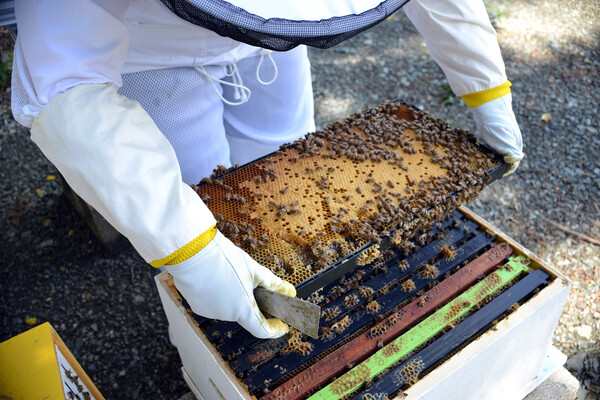
nocred
The PennCard is the official identification card for students, faculty, and staff at the University, and other members of the Penn community. It can literally open doors to campus buildings and authorizes free use of Penn Transit Services, free admission to the Penn Museum and the Morris Arboretum, access to items at Computer Connection, and a 10 percent discount at the Penn Bookstore for faculty and staff.
A staff of six—four full-time employees and two employees from Unique Advantage—operate The PennCard Center, which is located on the second floor of the Bookstore, 3601 Walnut St., and open Monday through Friday, 8:30 a.m. to 5 p.m.
In November, Angela Goldston was named the Center’s director after having served as associate director since 2011.
Goldston, who was born and raised in South Philadelphia but resides in Upper Darby, oversees the functions of The PennCard Center and its operational, financial, and project initiatives, including ensuring that customers receive professional and courteous service. She is currently overseeing a University-wide re-carding initiative that is replacing the old magnetic strip PennCards with new ones that contain a contactless chip. The new cards enable access to buildings without swiping.
First piloted in the summer of 2014, the re-carding initiative is more than three-quarters complete.
The Current sat down with Goldston to discuss the re-carding initiative, the many functionalities of the PennCard, its other uses besides building entry, and being a proud Penn parent.
Q: Tell me about the re-carding initiative. Why did you decide to update the PennCard?
A: The Division of Public Safety (DPS) has been installing new card readers on campus, so now our cards integrate with those new readers. The purpose is, obviously, for safety and for convenience. You don’t have to swipe any longer; now you can just tap the card.
Q: You started rolling out the contactless cards in July 2014 at the Singh Center for Nanotechnology and Gregory College House. Where are you in the re-carding process?
A: Right now, 76 percent of the campus has been re-carded. We held different re-carding initiatives on campus throughout the University. I think we did around 10 where we actually took our operations on the road and we came to different buildings to make it more convenient for people to get the new card in their hands. Initially, we were going to just transition where people were going to get their new card as their old PennCard expired, but we accelerated the program and we’re almost finished re-carding them within a year.
Q: Is there a fee to upgrade to the new PennCard?
A: No, there's no charge. If you bring your old card in with you, we can replace it with your new card. We're asking anyone who still has the old card to come in and get a new one.
Q: Have you received any feedback about the new card?
A: I think people really like the new card. They like the new design because not only do we have the chip, but the design of the card changed, too, and it had been 10 years since we had changed the design.
Q: Obviously PennCards are used for access to buildings. How else is the card used?
A: The students use it for their dining plans. Students, faculty, and staff can use it for PennCash. PennCash is an account that you can use on your PennCard where you can load money onto your account and use it at different places on campus. Also, we partner with PNC and the Student Federal Credit Union where your actual PennCard can be used as a debit card if you have an account with either one of those institutions. In our office, we actually have a PNC representative. You can open accounts there, ask any questions, so there’s always a resource within our office for PNC Bank.
Q: What other services does The PennCard Center provide in addition to making PennCards?
A: We are a service center so we do notaries, passport photos, and we sell stamps.
Q: How is the new PennCard Center location? It looks much improved than your old location in the Franklin Building.
A: It’s definitely brighter and more beautiful. We love the fact that we’re in the Bookstore so people can come into the Bookstore and browse. It complements the fact that we’re near another Business Services partner, which is Computer Connection.
Q: Do you recommend wearing a PennCard around the neck or keeping it in a purse or wallet?
A: DPS would prefer that you carry your card around your neck, and we do have lanyards and badge holders for you to be able to do that. The challenge sometimes is the card itself is very sensitive because it does have a chip with an antenna surrounding the card. If you have it in your pocket, you could damage the card, so we try to encourage people to use the lanyard and badge holder.
Q: Do employees in the Health System have PennCards?
A: They have a different card. However, people from the Health System can come and buy a PennCard. Most of them do that to use the recreation centers or libraries on campus.
Q: Who in the Penn community can get a PennCard besides employees? I understand spouses can have PennCards as well.
A: We obviously have the faculty, staff, and student population, but we also have other affiliates. We have alumni that have PennCards. Spouses can have PennCards, visiting scholars, visiting students, temporary staff, like part-time temporary staff. There are different affiliates on campus that also have the cards.
Q: Other than the re-carding, does The PennCard Center have any other new initiatives in the works?
A: One of the things that we’re working on that’s coming in the future is right now students can get their PennCards online, and we will be rolling out an application where faculty, staff, and students will be able to renew their cards online. It should be rolled out in the first quarter of 2016. Also, eventually we would like to go down the road of integrating our card with SEPTA’s technology.
Q: How many PennCards do you produce annually?
A: I would say normally we produce about 40,000 cards per year. This year is going to be a lot higher because of the re-carding initiative.
Q: Why were you interested in working at Penn?
A: Who wouldn’t want to work at Penn? My background is in finance. I was home for about seven years. I homeschooled my daughter from first grade through seventh grade, and during that time I was doing some tutoring with one of the local community colleges. I also taught GED classes, so that really gave me an interest in higher ed.
Q: Why did you decide to homeschool your daughter?
A: At the time, we were surrounded by a lot of parents who had homeschooled their children, and we really liked the fruit of what we saw. A lot of people are concerned that their [homeschooled] children may lack social skills, but personally for us, if anyone was going to be an influence at such a tender age, it was great for us to be that primary means of influence in her life. It was an opportunity for us to instill some of our values and our beliefs. And I say all the time that we were very vigilant about making sure that she did have the social piece. We wanted to make sure that she was engaged in different social activities.
Q: Your daughter, Joelle, is now a freshman at Penn. How is it being a Penn parent?
A: It’s great. I had a chance to meet other parents that work here, too, which is great. I couldn't be more proud.
Q: Did you sell Penn to your daughter or did the University sell itself?
A: I did not. It sold itself. To be honest, I purposely did not even mention Penn as an option because she really liked the D.C. area. Then one day she went to one of the [Penn] open houses and she came back and she said, 'Guess what? I like Penn.'

nocred

The sun shades on the Vagelos Institute for Energy Science and Technology.
nocred

Image: Kindamorphic via Getty Images

nocred